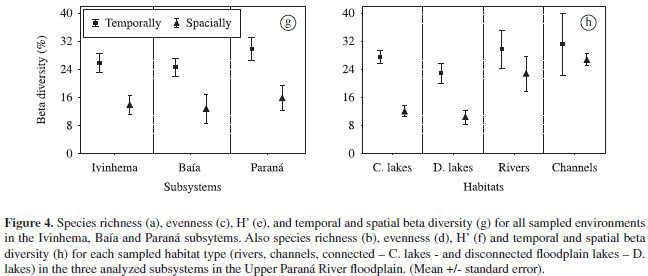Floodplain lakes and lotic environments of the High Paraná River floodplain present notable biodiversity, especially in relation to phytoplanktonic community. The goal of this work was to evaluate phytoplankton diversity (alpha, beta and gamma) in three subsystems during two years of drought (2000 and 2001). We sampled 33 habitats at the pelagic zone subsurface during February and August. Due to low hydrometric levels of the Paraná and Ivinhema Rivers, there was no clear distinction between the potamophase and limnophase periods for the two hydrosedimentological cycles analysed. We recorded 366 taxa. The values obtained for gamma diversity estimators ranged from 55.5-87.8%. DCA and variance analyses revealed only spatial differences in the phytoplankton composition. The mean values of species richness, evenness and Shannon diversity were low, especially when compared to those obtained in previous periods for Baía subsystem. The highest mean values of species richness were verified in the connected floodplain lakes. The highest beta diversity was obtained from the Paraná subsystem and lotic environments in 2001. In general, we observed that the Upper Paraná River floodplain has the highest values of species richness, evenness and H' during the potamophase period, when the flood facilitates dispersion. However, this pattern was not observed in 2000 and 2001, years influenced by La Niña. Besides the low precipitation observed during that period, we must consider the influence of the Porto Primavera impoundment, which also altered the discharge regime of the Paraná River by decreasing the degree of connectivity between fluvial channels and the lentic environments of the floodplain. Thus, the prevalence of conditions characterising the limnophase during 2000 and 2001 explains the lack of significant variability registered for most components of phytoplankton diversity over the study period. We conclude that variations in phytoplankton diversity during the study period were related to the absence of conspicuous potamophase, and that observed variations were more closely related to spatial heterogeneity. These results reveal the importance of conservation in the Área de Proteção Ambiental das Ilhas e Várzeas do Rio Paraná, with its subsystems and diverse aquatic habitats.
Phytoplankton; diversity; connectivity; spatial and temporal variability; conservation










